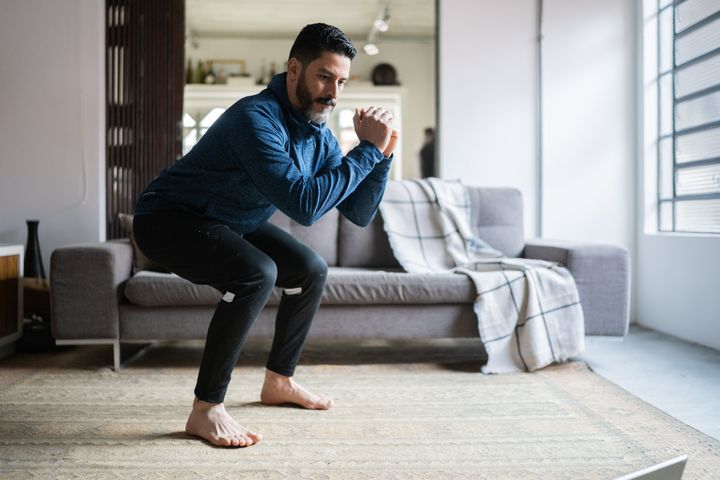Our bodies are happiest when they’re fueled with food, hydrated and practicing regular movement that makes us feel good. When it comes to movement, experts say there are specific exercises — known as primal movement — that we are hard-wired to understand because of the regular motions our cave-dwelling ancestors employed to survive.
“It’s the idea that these are things that we needed to do long before weights were invented or kettlebells were designed,” said Katie Gould, the founder of KG Strong, a strength-training gym in Philadelphia. Things like pulling ourselves up on a tree branch or carrying food home.
“These are things that one had to do to live and survive,” Gould said, noting that they’re instinctual movements. As babies, “we lie on our back, we roll onto our bellies, we push up into a tabletop position, we eventually get ourselves into a deep squat, and we make our way up to standing. Nobody’s teaching us how to do that — we’re learning how to do that because … we needed to learn how to walk and to feed ourselves and take care of ourselves.”
It’s a kind of movement that is fueled by necessity — and though we may not need to be as physical as our ancestors were, there are benefits to doing so. Here, experts share what those benefits are and how to infuse primal movement into your exercise routine.
First, know that your workout probably already involves primal movement.
According to Chelsea Cox, a Barry’s Charlotte principal instructor, the basic primal movements are squatting, lunging, pushing (like push-ups or chest presses), pulling (like pull-ups or rows), hinging (like hip hinges or good mornings), twisting (like Russian twists) and gaiting (like walking, jogging or running).
In other words, they’re exercises you are familiar with.
“Primal movements are actually things we are doing every single day,” Cox said. ”I think a lot of people think working out is this daunting thing because they have to do things that they’re unfamiliar with, but the truth is that when you squat down to pick something off the ground or you hinge to get your butt in the car to sit down” you’re doing those primal movements.
What’s more, you’re also probably already doing them pretty often in your weekly workouts, too — like every time you do a push-up, deadlift or lace up your sneakers for some sprints.
But if you want to focus more on primal movement, experts have some tips.
“One of the reasons why primal movements are so great is because you can do them anywhere — in a gym or at home,” Gould explained. This is because you don’t need weights to practice these movements (although they can be made more challenging with this addition) and you don’t need much space.
If your goal is mobility improvement or core stability, you can focus on bodyweight exercise, Gould said. One way to do this is by practicing crawl variations (like bear crawls where your knees are lifted off the ground as you crawl and even baby crawls with your hands and knees on the ground).
Squats are another great way to incorporate primal movement. Gould suggested that once you get yourself into a deep squat position, you can try hanging out there for a few breaths — and if you keep your heels down and your spine vertical, you’ll get yourself in a nice open-hip position.
She added that roll patterns are another good movement option. This includes advanced and structured exercises like Turkish get-ups and more beginner-friendly moves like efficiently rolling from your back to your side or from your side to a kneeling position.
“[Roll patterns are] really an undertrained skill and a really important one, especially for folks who are getting a little bit older,” Gould said. In fact, it’s important for everyone, and especially older people, to know how to efficiently and properly get from their back to a more vertical position, she added.
FG Trade via Getty Images
Outside of traditional workout exercises like those mentioned above, simple acts can also be considered primal movements. “I think sometimes when it comes to getting down to the floor, we’ve really gotten away … I don’t know if it’s out of fear … getting down has turned into a six-step process for a lot of people,” Gould said.
She added that people are afraid of bending their knees, worried about their ankle mobility or simply afraid they won’t be able to get up once they’re down.
“Getting down and picking things up, that is how most people injure themselves, and it’s because of a lack of efficiency and lack of body awareness [and] a lack of instinctual movement,” she said.
Practicing getting down to the ground and getting back up safely can be a useful way to avoid pain and injury and improve the overall quality of your movement. You can do this by practicing things like the roll patterns or squats mentioned above.
Overall, these movements will only help your strength, flexibility and mobility.
Primal movement “really is such a human movement that we do need, [and] the more that we do them the better we become at them,” Cox said.
Doing these movements throughout the day will help you feel stronger and will also help you realize how often you engage your muscles outside of a workout, she said — like when you lift up a heavy bag of groceries or hold your dog’s leash during a walk.
“It’s never too late to start practicing these moves, and it’s OK to start out with body weight,” Cox said. “Take your time, practice them daily and have fun with it.”
Lastly, she stressed that you should do a dynamic warm-up before exercising, whether that’s walking and driving your knees toward your chest or doing some lateral lunges.
Additionally, by doing these primal movements, you’re giving your body a break from the not-at-all primal position many people are in every day. That’s sitting in a chair, with your arms up and shoulders rounded while staring at a computer screen, Gould said.
“We’re basically putting ourselves into a position that’s very unnatural and stuck, so when you practice carrying or crawling or squatting or lunging, you’re focusing on the efficiency of movement and alignment,” Gould said.
But, she said, just because primal movement is instinctual does not mean it’s easy, and that is true for both those who are new to exercise and those who are competitive athletes.
It’s important to remember that everyone has limitations or alignment issues, but by practicing these movements, you can address your body’s challenges while also getting stronger, Gould noted.


